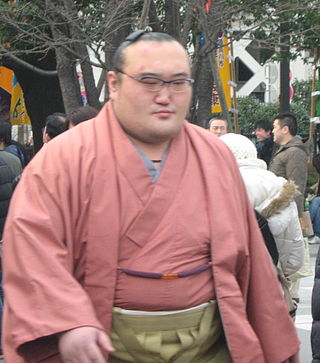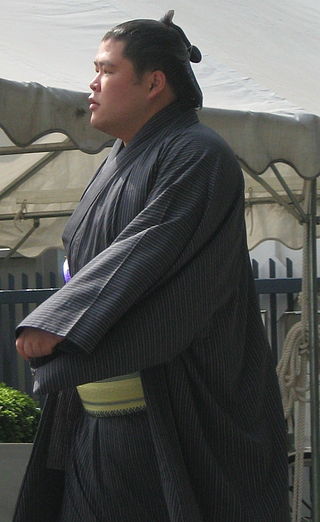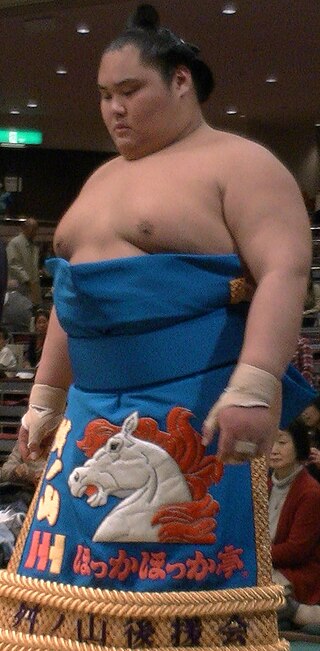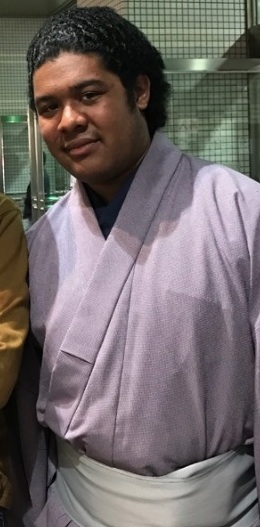Related Research Articles

Iwakiyama Ryūta, is a former sumo wrestler. A former amateur sumo champion, he turned professional in 2000 and reached the top division at the end of 2002. The highest rank he reached was komusubi. He was a runner-up in one tournament and earned two special prizes in his career. After his retirement in 2010 he became an elder of the Japan Sumo Association under the name Sekinoto.

Kakizoe Tōru, is a former sumo wrestler. A former amateur champion, he turned professional in 2001 and reached the top division in 2003. His highest rank was komusubi, which he held for just one tournament. He won one special prize, for Technique. After injury problems he fell to the third makushita division in 2011 and retired in April 2012, becoming a sumo coach. He was part of ex-yokozuna Musashimaru's Musashigawa stable from 2013 until 2020, when he moved to Irumagawa stable. He is now a sumo elder, under the name Ikazuchi (雷).
Professional sumo as administered by the Japan Sumo Association is divided into six ranked divisions. Wrestlers are promoted and demoted within and between these divisions based on the merit of their win–loss records in official tournaments. For more information, see kachi-koshi and make-koshi. Wrestlers are also ranked within each division. The higher a wrestler's rank within a division is, the stronger the general level of opponents he will have to face becomes. According to tradition, each rank is further subdivided into East and West, with East being slightly more prestigious, and ranked slightly higher than its West counterpart. The divisions, ranked in order of hierarchy from highest to lowest, are as follows:

Yoshikaze Masatsugu is a former sumo wrestler from Saiki, Oita Prefecture, Japan. His highest rank was sekiwake. A former amateur sumo champion, he turned professional in 2004, reaching the top division two years later. Until his promotion to komusubi in May 2014 he had the active record for the longest serving makuuchi wrestler who had never reached a titled rank. His best performance in a tournament came in July 2015 when he was the runner-up and scored twelve wins against three losses. In the following tournament in September 2015 he defeated two yokozuna and won special prizes for Outstanding Performance and Technique. Yoshikaze is in second place for the slowest promotion from makuuchi debut to the third highest sekiwake rank in history, behind only his stablemate Takekaze. He won ten special prizes in total, and eight gold stars for defeating yokozuna. He retired in September 2019 and is now an elder of the Japan Sumo Association, known as Nakamura Oyakata.
The following words are terms used in sumo wrestling in Japan.

Ryūhō Masayoshi is a former sumo wrestler from Nakagami, Okinawa, Japan. His highest rank was maegashira 16.

Hamanishiki Tatsurō is a former sumo wrestler from Kumamoto, Japan. A former amateur champion, he made his professional debut in 1999. His highest rank was maegashira 11, which he reached in 2002. He was mostly ranked in the makushita and sandanme divisions from 2005 until his retirement in 2012. He became an elder of the Japan Sumo Association upon his retirement and was the head coach of the Kasugayama stable from 2012 until 2016.
Ryōgoku Kajinosuke IV is a former sumo wrestler from Nagasaki, Japan. His highest rank was komusubi. He is now a sumo coach under the name of Sakaigawa.

Kushimaumi Keita, born as Keita Kushima, was a sumo wrestler from Shingū, Wakayama Prefecture, Japan. A successful amateur, his highest rank in professional sumo was maegashira 1. After his retirement he became an elder of the Japan Sumo Association and established Tagonoura stable.

Aran Hakutora is a Russian former sumo wrestler. He began his professional career in January 2007 and made the top division in a record eleven tournaments. The highest rank he reached was sekiwake. He was runner-up in consecutive tournaments in May and July 2010 and earned two sanshō or special prizes for Fighting Spirit. He wrestled for Mihogaseki stable.

Shōtenrō Taishi is a former sumo wrestler from Khovd Province, Mongolia. He joined professional sumo in 2001 and was known as Musashiryū Taishi until 2007. He made the top makuuchi division for the first time in 2009 and his highest rank was maegashira 2. He wrestled for Fujishima stable. He acquired Japanese citizenship in 2017 and retired shortly before the January 2018 tournament to become an elder of the Japan Sumo Association. As of June 2022 he is known as Nishikijima Oyakata.

Tosayutaka Yūya is a former sumo wrestler from Tosa City, Kōchi Prefecture, Japan. He made his professional debut in March 2007, reaching the top makuuchi division in July 2009. His highest rank was maegashira 1. After a long hiatus due to injury, he worked his way back up the ranks, logging several lower division championships on the way. In January 2015 he finally reached the top division again after an 18 tournament absence. His comeback from sandanme 84 was the lowest any wrestler since World War II has fallen and still managed to again reach the top division, until surpassed by Terunofuji. After further injury setbacks he announced his retirement in January 2016. He became stablemaster of Tokitsukaze stable in February 2021 after the Japan Sumo Association asked the previous stablemaster to retire.

Aoiyama Kōsuke is a Japanese professional sumo wrestler or rikishi from Elhovo, Bulgaria. He made his professional debut in 2009, reaching the top division two years later, debuting in the November 2011 tournament. Aoiyama has won four Fighting Spirit awards, one Technique award and one kinboshi for defeating a yokozuna. He has twice been runner-up in a tournament. His highest rank has been sekiwake. Aoiyama is one of the heaviest competitors in sumo, weighing around 200 kg for most tournaments. In March 2022, he obtained Japanese citizenship.

Jōkōryū Takayuki is a Japanese former professional sumo wrestler. He made his professional debut in 2011 after a successful college career in sumo. He currently holds the record for the most consecutive wins since entering professional sumo, with 27, and for the fastest rise to the top makuuchi division from the lowest jonokuchi division. His highest was komusubi, which he reached in September 2014. However, because of injuries he fell down the rankings, reaching a low of sandanme 23 in November 2016. He returned to the jūryō division for four tournaments from November 2020 until May 2021, but announced his retirement in September 2022 having fallen to the makushita division.

Masunoyama Tomoharu is a Japanese former professional sumo wrestler from Sakae, Chiba. He turned professional in July 2006 and was the first wrestler born in the Heisei era to become a sekitori when he was promoted to the jūryō division in November 2010, alongside Takayasu. He reached the top makuuchi division in September 2011. He was injured in his top division debut and fell back to jūryō, but he returned in July 2012 and scored eleven wins, winning the Fighting Spirit Award. A serious knee injury sustained in 2015 resulted in him falling greatly in rank, and he was not able to return to sekitori status. He retired in May 2021.

Kagamiō Hideoki is a former Mongolian-born professional sumo wrestler from Ulaanbaatar. He made his debut in July 2003 for Kagamiyama stable. He reached the jūryō division in January 2013 and the top makuuchi division a year after that. His highest rank was maegashira 9. Following a long-term injury layoff he fell off the banzuke or ranking sheets in 2021. In March 2023 he obtained Japanese citizenship.
The following were the events in professional sumo during 2016.

Wakaichirō Ken is a former professional sumo wrestler with the Musashigawa stable from Houston, Texas. He retired after earning his highest career rank, sandanme 32.
Masaru Maeta, known by his shikonaMaeta (前田), was a Japanese sumo wrestler from the city of Tsuruoka in Yamagata Prefecture. He was a former amateur sumo competitor for Nihon University and made his professional debut in 2005. His sumo stable was Shibatayama and previously he belonged to Hanaregoma. His height was 180 cm and his peak weight was 213 kg (470 lb). His highest rank was makushita 3. He retired in 2018.

Meisei Chikara is a Japanese professional sumo wrestler from Setouchi, Kagoshima. He debuted in sumo wrestling in July 2011 and made his makuuchi debut in July 2018. His highest rank has been sekiwake. He wrestles for Tatsunami stable. Unusually for a top-class sumo wrestler, he uses his given name as his shikona.
References
- 1 2 Gilbert, Howard (February 2009). "Amateur angles" (PDF). Sumo Fan Magazine. Retrieved 2009-09-23.
- ↑ Buckton, Mark (Jan 23, 2007). "Numbers break records, character creates legends". Japan Times. Retrieved 5 October 2016.
- ↑ Kintamayama (May 27, 2009). "May 2009 retirees". Sumo Forum. Retrieved 5 October 2016.
- ↑ "Aotsurugi Kenta Rikishi Information". Sumo Reference. Retrieved 5 October 2016.